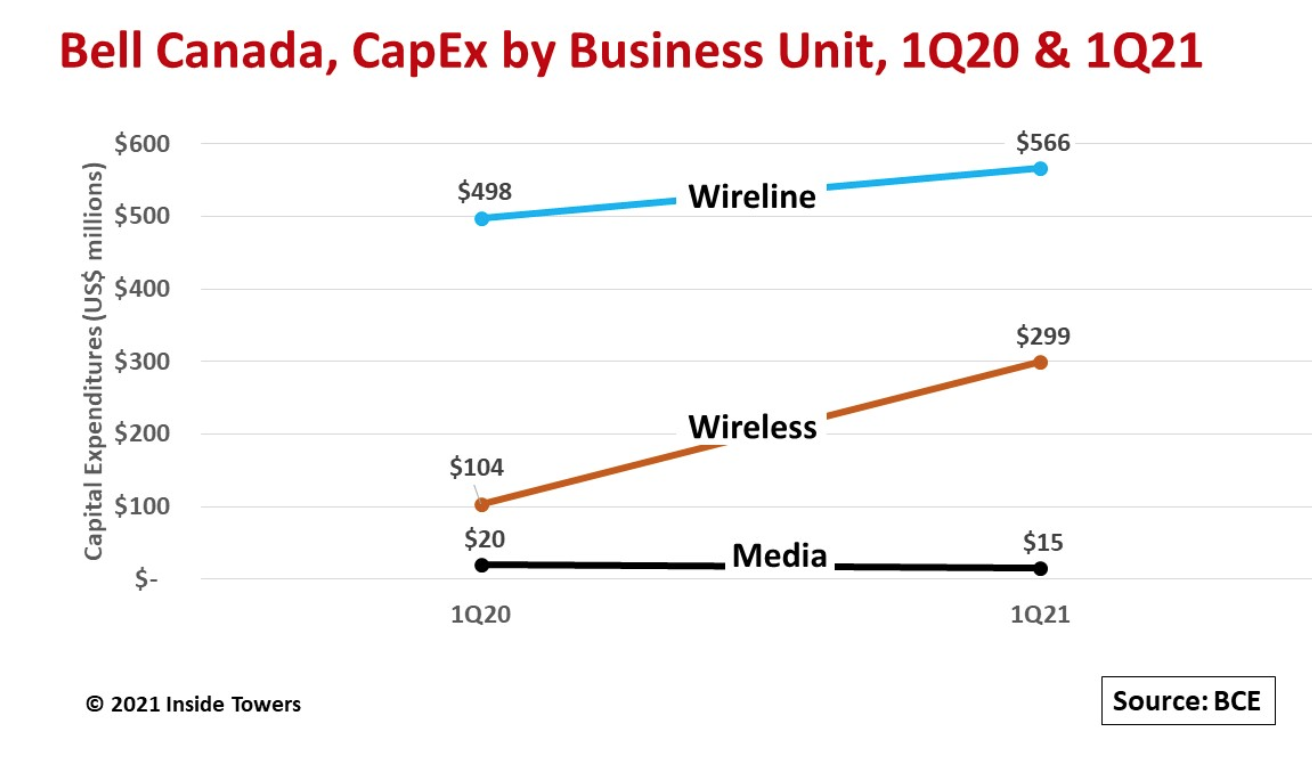In February, Bell Canada, wholly owned by Montréal, Québec-based BCE Inc. (NYSE: BCE), announced that it would accelerate plans to expand its fiber and wireless networks with an additional $1 billion in capital expenditures over the next two years.
Bell’s capex budget typically runs $3.0-3.2 billion* a year. The company will use the enhanced capex to expand wireline fiber-to-the-home deployments and the number of rural Wireless Home Internet locations while doubling 5G population coverage in 2021.

Bell’s base of operation is in Ontario and Québec. The company expanded east and west, first into the Atlantic provinces by acquiring Aliant in 2014, then into central Canada when it bought Manitoba Telephone System in 2017.
Bell Wireline has 6 million telephone, TV and internet connected locations across that operating area. Bell Wireless overlays those wireline operations in eastern Canada but relies on a network sharing agreement with Telus (NYSE: TU), headquartered in Vancouver, British Columbia, to cover the western half of the country. Bell Wireless had 9.2 million nationwide postpaid and prepaid subscribers at the end of 1Q21.
The combined 1Q21 operating revenues among Bell’s Wireless, Wireline and Media operations were $4.6 billion, up just one percent compared to 1Q20. Of that total, Wireline generated $2.5 billion or 54 percent, Wireless contributed $1.7 billion or 37 percent, while Media came in at $570 million.
Wireless capex in 1Q21 was $229 million or 28 percent of the total, but growing 120 percent compared to $104 million in 1Q20. Wireline accounted for $566 million, or 70 percent of the $810 million total spent in the quarter, growing 14 percent YoY. Media declined 24 percent on a YoY basis to $15 million as TV, radio, and outdoor advertising dropped during the pandemic.
At the time of the announcement, Mirko Bibic, company President and CEO, said, “Bell has offered critical support to Canadians throughout COVID-19, and we are proud to ensure our networks will play a key role in the country’s move forward as we announce our plan to accelerate the rollout of Bell network connections to hundreds of thousands of additional locations in urban and rural communities alike this year.”
The incremental $1 billion is funded from the proceeds of Bell’s sale of its data centers to Equinix (NASDAQ: EQIX) in 2020. Using these funds for expansion, Bell will also leverage accelerated expensing of capex under the federal capital cost allowance program, generating cash tax savings that can be reinvested in infrastructure development.
Of that total, Bell will invest approximately $560 million in 2021 to accelerate both its wireless and wireline network footprints.
This supplemental capex will go towards 1.5 Gbps fiber deployments covering roughly 400,000 homes and businesses in populated areas and will increase rural Wireless Home Internet service coverage to as many as 900,000 locations. The company expects its total broadband footprint to reach roughly 6.9 million locations by the end of 2021.
At the same, Bell Wireless plans to double its 5G national population coverage that currently serves more than 150 communities across Canada.
In May, Bell upped the ante by another $400 million bringing its total capex in the 2020-2022 period to over $11 billion.
The increased investment came in response to the Canadian Radio-television and Telecommunications Commission’s (CRTC) decision, supported by ongoing government policy, for facilities-based competition and investment. Prior to that decision, the CRTC contemplated mandates for lower internet rates for consumers. Ultimately, it decided that the market should set such rates.
Besides significantly increasing its wireline and wireless connections across Canada over the next two years, Bell believes the investment will create employment opportunities as network construction activity speeds up.
Bibic added, “The unprecedented impacts of the crisis have necessitated a bold response from all stakeholders in Canada’s economy, and Bell responded with the largest capital acceleration project in our company’s 141-year history. Now, with greater regulatory stability fostering an improved investment climate, Bell is proud to take our plan even further by growing our investment to advance how Canadians in communities large and small connect with each other and the world.”
With 5G coverage now at approximately 35 percent of the Canadian population, Bell recently announced the expansion of its 5G network to a further 23 cities and towns in Québec, Ontario, and Manitoba, and is on track to reach up to 70 percent national 5G coverage this year.
BCE (bce.ca) will provide updates on its progress in its Q2 2021 earnings call, scheduled for Thursday, August 5, 2021, at 8:00 a.m. ET.
*all currency in USD.
By John Celentano, Inside Towers Business Editor




Reader Interactions